英语常见的介词及用法
- 格式:doc
- 大小:19.50 KB
- 文档页数:4
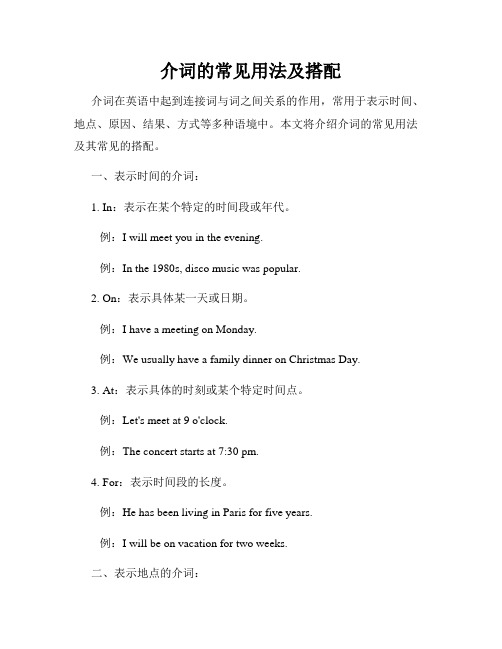
介词的常见用法及搭配介词在英语中起到连接词与词之间关系的作用,常用于表示时间、地点、原因、结果、方式等多种语境中。
本文将介绍介词的常见用法及其常见的搭配。
一、表示时间的介词:1. In:表示在某个特定的时间段或年代。
例:I will meet you in the evening.例:In the 1980s, disco music was popular.2. On:表示具体某一天或日期。
例:I have a meeting on Monday.例:We usually have a family dinner on Christmas Day.3. At:表示具体的时刻或某个特定时间点。
例:Let's meet at 9 o'clock.例:The concert starts at 7:30 pm.4. For:表示时间段的长度。
例:He has been living in Paris for five years.例:I will be on vacation for two weeks.二、表示地点的介词:1. In:表示在某个大范围的地点。
例:She lives in New York.例:They are studying in the library.2. On:表示在某个平面或具体的地点上。
例:The book is on the table.例:I saw her on the beach yesterday.3. At:表示在某个具体的地方或建筑物。
例:They are waiting at the bus stop.例:The party is at my house tonight.4. By:表示经过某个地点。
例:I go to work by bus every day.例:They traveled to the city by train.三、表示原因的介词:1. Because of:表示由于某个原因。

常见的英语介词及其用法英语介词的用法非常灵活,以下是常见的英语介词及其用法:1.表示地理位置的介词:•at:用于表示具体的位置,如at the table(在桌子旁)•in:用于表示在某个大地方或空间中,如in the house(在房子里)•on:用于表示在某个平面上或物体表面上,如on the table (在桌子上)•to:用于表示方向,如to the left(向左)案例:He lives in a small town near London.(他住在伦敦附近的一个小城镇里。
)2.表示时间的介词:•at:用于表示具体的时间点或时刻,如at noon(在中午)•in:用于表示在一个时间段内,如in the morning(在早晨)•on:用于表示在某个具体日期或时间范围,如on Monday (在星期一)•since:用于表示从某个时间点或时刻开始,如since last week(从上周开始)案例:I usually go to bed at 11 o'clock.(我通常在11点睡觉。
)3.表示方式的介词:•by:用于表示通过某种方式或交通工具,如by bus(乘公共汽车)•with:用于表示使用某种工具或方法,如with a knife(用刀子)•in:用于表示使用某种语言或穿着某种衣服,如in English (用英语)•on:用于表示在某种媒介上,如on TV(在电视上)案例:We usually communicate with each other by email.(我们通常通过电子邮件彼此沟通。
)4.表示原因的介词:•for:用于表示为了某个目的或原因,如for help(为了寻求帮助)•from:用于表示由于某个来源或原因,如from fear(由于恐惧)•about:用于表示关于某个话题或事件,如about the weather (关于天气)案例:She is studying for the exam.(她正在为考试而学习。

15个英语最常见介词(in on at of for...)的深层次含义英文中15个最常见的介词in/ on/at/of/ for/by /with/ from/to/as/ about/ around/ off/ through/ over一、in (在..里面)1.表示真实的位置: in the car/room2表示抽象的位置: in the book/movie3.表示状态: in danger, in trouble; in anger3.表示时间: in the morning/afternoon/evening. in April; in 20104.表示方式: in the way; in English5.表示穿着: in black shoes/T-shirt二、on (紧紧地接触-连着)1.表示真实的位置: on the table/wall2.表示抽象的位置: on the radio/TV; on the topic/event3.表示具体的时间: on Monday; on Monday morning; on May 4th4.表示状态: on duty; on holiday; the game is on三、at(在.点上)1.表示真实的位置: at home/the company/the store2.表示抽象的位置: be good/bad at English3.表示具体的时间: at 3 pm;at night; at the age of 204.表示状态: at work-在工作; at table-在吃饭四、Of(的-从属关系)1.表示"无生命主体的":the window of the room; top of the mountain...2.某某市: the city of Bejing3.表示数量: a piece/bx/bottle/pair.. of五、for(为了/因为/对时间/对.而言/支持赞成)1.表示为了":go for a walk; I come here fr my schoolbag2.表示"因为": Thank you for helping me; for the reason3.表示"时间"和: for 3 days; for a week; for a year4.表示对..而言": It is important for me5.表示”支持,赞成": Are you for this plan or against it?六、by(通过.交通工具/在.附近/街至.时间/被)1.表示"通过.交通工具":by train/subway/plane/air/ship/seaI learn English by watchingEnglish movies.2.表示在附近":a table by the window; the house is by the lake3.表示"截至到..时间":by the end of next week; by 20194.表示"被(被动语态)":English is spoken by people all over the world.七、with (伴随)1.表示"和.起":go with:play with;make friends with;cooperate with2.表示"携有,带有":a county with a long history; a house with a big garden3.表示..工具:cut the apple with the knife4.表示"伴随":with the development of the society;with the help of my teacher;I don't have any cash with me.八、from (远离)1.表示"来自":I am/come from China;a gift from my best friend;a man from America2.由"远离"来记短语:stop/prevent/keep sb from doing sth阻止某人做某事be away from...远离...be different from与.不同be absent from缺席....how far is it from here?它离这远The paper is made from wood.这纸是由木头制成的3.表示..到": from...to...由"指向"来理解下列用法:The road leads to Paris.这条路通往巴黎Smoking is harmful to your health.吸烟有害健康the answer to the question.这个问题的答案九、to (指向..)contribute to对..做贡献on one's way to... 在某人去某地的路上belong to属于..be used to doing sth习惯于做某事lead to...导致十、as作为He works as a tour guide.他作为导游工作。

英语常见介词整理
介词是英语语法中的一种重要词汇,用于连接名词、代词或动词与其他句子成分。
以下是一些常见的英语介词及其用法:
1. in - 表示在某个位置或时间内,如:in the room, in the morning
2. on - 表示在某个表面或时间上,如:on the table, on Monday
3. at - 表示在某个地点或时间点上,如:at the airport, at 2 o'clock
4. to - 表示动作的方向或目的地,如:go to school, send a letter to someone
5. from - 表示源头或出处,如:from China, from the store
6. with - 表示伴随或使用某物,如:go with me, write with
a pen
7. by - 表示手段或方法,如:travel by plane, study by yourself
8. for - 表示目的或受益人,如:buy a gift for her, work for
a company
9. of - 表示所属关系或材料,如:a book of poems, a friend of mine
10. about - 表示关于某事物的内容或主题,如:talk about the weather, a book about history
以上是常见的英语介词,需要在语境中灵活运用。
同时,还有一
些短语动词和介词搭配使用,如:look forward to, rely on, take care of等,也需要掌握和熟练使用。

史上超全的英语介词用法归纳总结!不看太可惜了英语介词是一种非常重要的语法成分,用于表示名词与其他句子成分之间的关系。
以下是史上超全的英语介词用法归纳总结:1.基本介词:- in:在...内部- on:在...表面- at:在...位置或时间点- by:通过其中一种方式- with:用物- from:从...来- to:到...去- for:为了- of:属于...的2.时间介词:- in:用于特定时间段,如in the morning(在早上)- on:用于特定日期或星期,如on Monday(在星期一)- at:用于具体时间点,如at 3 o'clock(在3点钟)3.地点介词:- in:用于大的地理范围,如in China(在中国)- on:用于较小的地理范围或表面,如on the street(在街上)- at:用于具体地点,如at the supermarket(在超市)4.方向介词:- to:表示到达一些地方,如go to school(去学校)- into:表示进入一些地方,如go into the house(进入房子)- out of:表示离开一些地方,如get out of the car(离开车)5.原因介词:- because of:由于,如He is late because of the traffic(他因为交通堵塞而迟到)- due to:由于,如The flight was canceled due to bad weather(因为恶劣天气,航班被取消)6.动词短语介词:- look after:照顾,如She looks after her younger brother (她照顾她的弟弟)- take care of:照顾,如He takes care of his plants(他照顾他的植物)7.形容词短语介词:- interested in:对...感兴趣,如She is interested in music (她对音乐感兴趣)- good at:擅长...,如He is good at playing basketball(他擅长打篮球)8.其他常见介词用法:- with regard to:关于,如With regard to the matter, I have something to say(关于这件事,我有些话要说)- instead of:代替,如I will go instead of him(我将代替他去)- according to:根据,如According to the weather forecast, it will rain tomorrow(根据天气预报,明天会下雨)以上是一些常见的英语介词用法总结,希望能帮到你!。

介词的用法及例句引言:介词是英语中非常重要的语法成分之一,它可以用来表示时间、地点、方式、目的等等关系。
正确使用介词不仅能够提升语言表达的准确性,还能让我们的表达更加流利自然。
本文将详细介绍介词的用法,并给出一些常见的例句来帮助读者更好地掌握。
一、表示时间关系的介词:1. On例句:I have a meeting on Monday.解析:这里的on指明了会议在周一这个具体日期上进行。
2. In例句:The concert will be held in November.解析:这里的in表示在11月份这个时间段内举行音乐会。
3. At例句:We will meet at 9 o'clock tomorrow morning.解析:at用于表示具体时间点,此处表示我们明天早上9点见面。
二、表示地点关系的介词:1. In例句:She lives in New York City.解析:in用于表示所处位置或范围,此处指她住在纽约市内。
例句:I will meet you at the coffee shop.解析:at表示在某个特定地方遇见某人,这里指我将在咖啡店见你。
3. On例句:The book is on the table.解析:on表示在某物的表面,这里指书本放在桌子上。
三、表示方式关系的介词:1. By例句:She goes to work by bus.解析:by表示通过某种交通工具或方式进行,这里指她乘公交车上班。
2. With例句:He cuts the meat with a knife.解析:with表示使用某物进行操作,这里指他用刀切肉。
3. Like例句:He speaks English like a native speaker.解析:like表示像某人或某事物一样,这里指他说英语像个母语者一样流利。
四、表示目的关系的介词:1. For例句:I bought some flowers for my mother.解析:for表示为了某人或某事物而做,这里我买花是为了给妈妈。
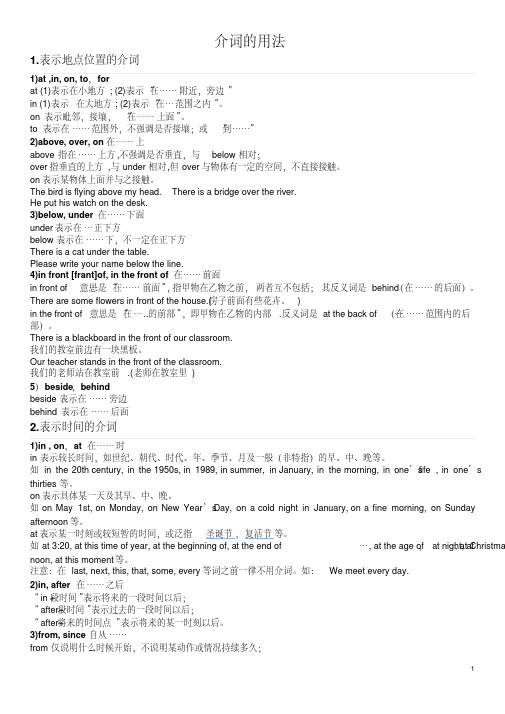
介词的用法1.表示地点位置的介词1)at ,in, on, to,forat (1)表示在小地方; (2)表示“在……附近,旁边”in (1)表示在大地方; (2)表示“在…范围之内”。
on 表示毗邻,接壤,“在……上面”。
to 表示在……范围外,不强调是否接壤;或“到……”2)above, over, on 在……上above 指在……上方,不强调是否垂直,与below相对;over指垂直的上方,与under相对,但over与物体有一定的空间,不直接接触。
on表示某物体上面并与之接触。
The bird is flying above my head. There is a bridge over the river.He put his watch on the desk.3)below, under 在……下面under表示在…正下方below表示在……下,不一定在正下方There is a cat under the table.Please write your name below the line.4)in front [frant]of, in the front of在……前面意思是“在……前面”,指甲物在乙物之前,两者互不包括;其反义词是behind(在……的后面)。
in front of…There are some flowers in front of the house.(房子前面有些花卉。
)in the front of 意思是“在…..的前部”,即甲物在乙物的内部.反义词是at the back of…(在……范围内的后部)。
There is a blackboard in the front of our classroom.我们的教室前边有一块黑板。
Our teacher stands in the front of the classroom.我们的老师站在教室前.(老师在教室里)5)beside,behindbeside 表示在……旁边behind 表示在……后面2.表示时间的介词1)in , on,at 在……时in表示较长时间,如世纪、朝代、时代、年、季节、月及一般(非特指)的早、中、晚等。
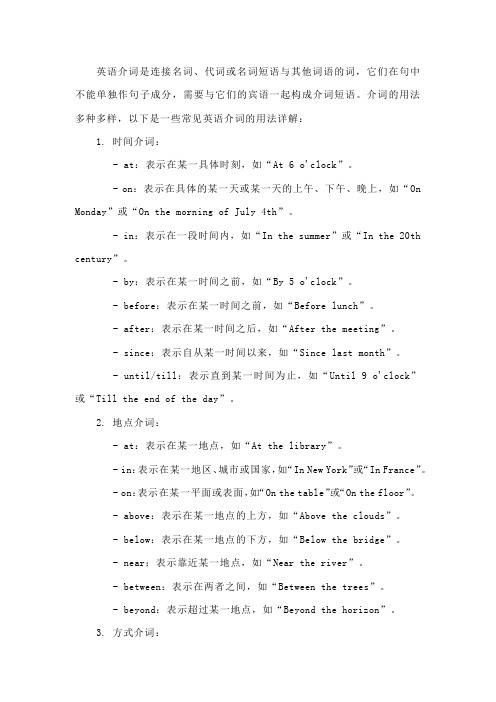
英语介词是连接名词、代词或名词短语与其他词语的词,它们在句中不能单独作句子成分,需要与它们的宾语一起构成介词短语。
介词的用法多种多样,以下是一些常见英语介词的用法详解:1. 时间介词:- at:表示在某一具体时刻,如“At 6 o'clock”。
- on:表示在具体的某一天或某一天的上午、下午、晚上,如“On Monday”或“On the morning of July 4th”。
- in:表示在一段时间内,如“In the summer”或“In the 20th century”。
- by:表示在某一时间之前,如“By 5 o'clock”。
- before:表示在某一时间之前,如“Before lunch”。
- after:表示在某一时间之后,如“After the meeting”。
- since:表示自从某一时间以来,如“Since last month”。
- until/till:表示直到某一时间为止,如“Until 9 o'clock”或“Till the end of the day”。
2. 地点介词:- at:表示在某一地点,如“At the library”。
- in:表示在某一地区、城市或国家,如“In New York”或“In France”。
- on:表示在某一平面或表面,如“On the table”或“On the floor”。
- above:表示在某一地点的上方,如“Above the clouds”。
- below:表示在某一地点的下方,如“Below the bridge”。
- near:表示靠近某一地点,如“Near the river”。
- between:表示在两者之间,如“Between the trees”。
- beyond:表示超过某一地点,如“Beyond the horizon”。
3. 方式介词:- by:表示通过某种方式或手段,如“By car”或“By phone”。
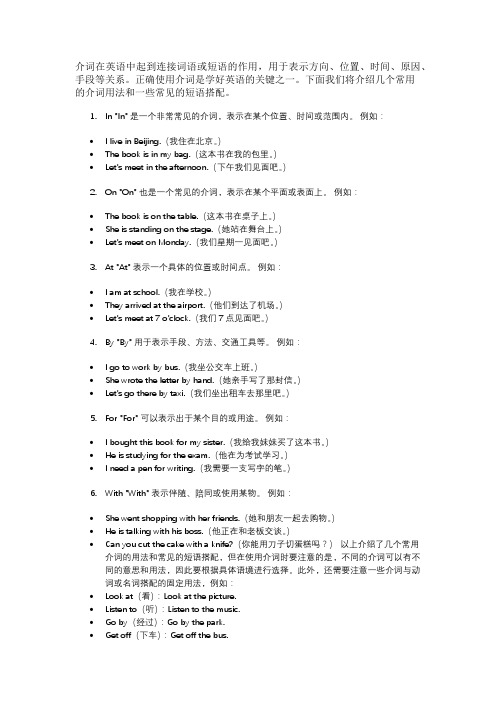
介词在英语中起到连接词语或短语的作用,用于表示方向、位置、时间、原因、手段等关系。
正确使用介词是学好英语的关键之一。
下面我们将介绍几个常用的介词用法和一些常见的短语搭配。
1.In "In" 是一个非常常见的介词,表示在某个位置、时间或范围内。
例如:•I live in Beijing.(我住在北京。
)•The book is in my bag.(这本书在我的包里。
)•Let's meet in the afternoon.(下午我们见面吧。
)2.On "On" 也是一个常见的介词,表示在某个平面或表面上。
例如:•The book is on the table.(这本书在桌子上。
)•She is standing on the stage.(她站在舞台上。
)•Let's meet on Monday.(我们星期一见面吧。
)3.At "At" 表示一个具体的位置或时间点。
例如:•I am at school.(我在学校。
)•They arrived at the airport.(他们到达了机场。
)•Let's meet at 7 o'clock.(我们7点见面吧。
)4.By "By" 用于表示手段、方法、交通工具等。
例如:•I go to work by bus.(我坐公交车上班。
)•She wrote the letter by hand.(她亲手写了那封信。
)•Let's go there by taxi.(我们坐出租车去那里吧。
)5.For "For" 可以表示出于某个目的或用途。
例如:•I bought this book for my sister.(我给我妹妹买了这本书。
)•He is studying for the exam.(他在为考试学习。

15个英语最常见介词(in on at of for...)的深层次含义英文中15个最常见的介词in/ on/at/of/ for/by /with/ from/to/as/ about/ around/ off/ through/ over一、in (在..里面)1.表示真实的位置: in the car/room2表示抽象的位置: in the book/movie3.表示状态: in danger, in trouble; in anger3.表示时间: in the morning/afternoon/evening. in April; in 20104.表示方式: in the way; in English5.表示穿着: in black shoes/T-shirt二、on (紧紧地接触-连着)1.表示真实的位置: on the table/wall2.表示抽象的位置: on the radio/TV; on the topic/event3.表示具体的时间: on Monday; on Monday morning; on May 4th4.表示状态: on duty; on holiday; the game is on三、at(在.点上)1.表示真实的位置: at home/the company/the store2.表示抽象的位置: be good/bad at English3.表示具体的时间: at 3 pm;at night; at the age of 204.表示状态: at work-在工作; at table-在吃饭四、Of(的-从属关系)1.表示"无生命主体的":the window of the room; top of the mountain...2.某某市: the city of Bejing3.表示数量: a piece/bx/bottle/pair.. of五、for(为了/因为/对时间/对.而言/支持赞成)1.表示为了":go for a walk; I come here fr my schoolbag2.表示"因为": Thank you for helping me; for the reason3.表示"时间"和: for 3 days; for a week; for a year4.表示对..而言": It is important for me5.表示”支持,赞成": Are you for this plan or against it?六、by(通过.交通工具/在.附近/街至.时间/被)1.表示"通过.交通工具":by train/subway/plane/air/ship/seaI learn English by watchingEnglish movies.2.表示在附近":a table by the window; the house is by the lake3.表示"截至到..时间":by the end of next week; by 20194.表示"被(被动语态)":English is spoken by people all over the world.七、with (伴随)1.表示"和.起":go with:play with;make friends with;cooperate with2.表示"携有,带有":a county with a long history; a house with a big garden3.表示..工具:cut the apple with the knife4.表示"伴随":with the development of the society;with the help of my teacher;I don't have any cash with me.八、from (远离)1.表示"来自":I am/come from China;a gift from my best friend;a man from America2.由"远离"来记短语:stop/prevent/keep sb from doing sth阻止某人做某事be away from...远离...be different from与.不同be absent from缺席....how far is it from here?它离这远The paper is made from wood.这纸是由木头制成的3.表示..到": from...to...由"指向"来理解下列用法:The road leads to Paris.这条路通往巴黎Smoking is harmful to your health.吸烟有害健康the answer to the question.这个问题的答案九、to (指向..)contribute to对..做贡献on one's way to... 在某人去某地的路上belong to属于..be used to doing sth习惯于做某事lead to...导致十、as作为He works as a tour guide.他作为导游工作。

语法|英语介词知识点用法总结!1.In(在,表示时间、地点、状态):- 表示具体的时间点或时间段:in the morning(早晨)、in May(五月)、in 2024(2024年)- 表示地点:in the park(在公园里)、in London(在伦敦)- 表示状态:in trouble(陷入困境)、in love(恋爱中)2.On(在,表示时间、地点、表面):- 表示具体的日期或星期几:on Monday(星期一)、on December25th(12月25日)- 表示地点:on the bus(在公交车上)、on Main Street(在主街上)- 表示表面:on the table(在桌子上)3.At(在,表示时间、地点):- 表示具体的时间:at 8 o'clock(在8点钟)、at noon(在中午)- 表示地点:at the cinema(在电影院)、at home(在家)4.To(到,表示方向或目的地):- 表示目的地:a trip to Paris(巴黎之行)、a letter to John (写给约翰的信)- 表示出发地:a flight from New York(从纽约起飞的航班)、a train from London(从伦敦开出的火车)- 表示原因:suffer from a cold(患感冒)6. For(为了,表示目的、受益人):- 表示目的:study for the exam(为考试而学习)、buy flowers for my mother(给母亲买花)- 表示受益人:a gift for you(给你的礼物)7. With(和,表示伴随、使用、具备):- 表示伴随:go shopping with friends(和朋友一起购物)、have dinner with family(和家人一起吃晚饭)- 表示使用:write with a pen(用钢笔写)- 表示具备:a girl with long hair(一位长发的女孩)以上是一些常见的英语介词及其用法总结,介词在句子中使用灵活多样,需要根据具体语境来选择适当的介词。

介词的基本用法介词是英语中一类常见的词汇,用于表示各种关系和位置。
在句子中,介词通常用来连接名词或代词,与其他词语形成短语,进一步表达句子的意思。
在本文中,我们将介绍介词的基本用法,并提供一些例子来加深理解。
1. 表示位置关系介词在英语中常被用来描述位置关系,包括在、上、下、旁边等。
以下是一些常见的表示位置关系的介词及其用法:- 在(on):表示某物在另一物体的表面或面上。
例如:The book is on the table.- 下(under):表示某物在另一物体下面。
例如:The cat is under the bed.- 在(in):表示某物在另一物体内部。
例如:The pencil is in the drawer.- 旁边(beside):表示某物在另一物体的旁边。
例如:The park is beside the supermarket.2. 表示时间关系介词也可用来表示时间关系,包括在、在...前、在...后等。
以下是一些常见的表示时间关系的介词及其用法:- 在(at):表示某一时间点。
例如:I'll meet you at 9 o'clock.- 在...前(before):表示在某一具体时间之前。
例如:Please finish your homework before dinner.- 在...后(after):表示在某一具体时间之后。
例如:I'll call you after I finish work.- 从...到...(from...to):表示一个时间范围。
例如:The shop isopen from Monday to Saturday.3. 表示方式、原因和目的介词还用于表示方式、原因和目的等。
以下是一些常见的表示方式、原因和目的的介词及其用法:- 通过(by):表示某种方式或方法。
例如:I go to work by bus.- 对于(for):表示某事情的目的或原因。
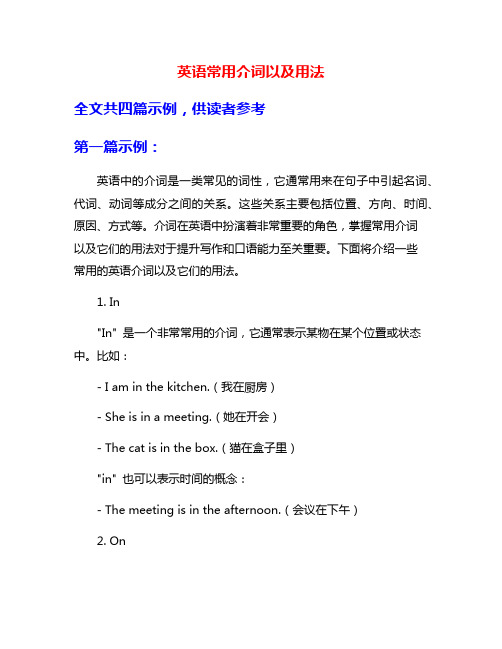
英语常用介词以及用法全文共四篇示例,供读者参考第一篇示例:英语中的介词是一类常见的词性,它通常用来在句子中引起名词、代词、动词等成分之间的关系。
这些关系主要包括位置、方向、时间、原因、方式等。
介词在英语中扮演着非常重要的角色,掌握常用介词以及它们的用法对于提升写作和口语能力至关重要。
下面将介绍一些常用的英语介词以及它们的用法。
1. In"In" 是一个非常常用的介词,它通常表示某物在某个位置或状态中。
比如:- I am in the kitchen.(我在厨房)- She is in a meeting.(她在开会)- The cat is in the box.(猫在盒子里)"in" 也可以表示时间的概念:- The meeting is in the afternoon.(会议在下午)2. On- We will have a party on Christmas Day.(我们将在圣诞节那天举办派对)3. At"At" 用于表示某物在某个具体的地点或时间。
比如:"At" 还可以表示某种状态或情况:4. By"By" 可以表示近旁、附近,或通过某种方式。
比如:- The park is by the river.(这个公园在河边)- She goes to work by bus.(她乘公交车上班)5. With"With" 表示陪伴、一起,也可以表示使用某种工具或手段。
比如:- He is happy with his new job.(他对他的新工作感到高兴)6. For"For" 通常表示目的、原因、利益。
比如:- I bought a gift for my sister.(我给我妹妹买了份礼物)- He is studying for the exam.(他正在为考试而学习)"From" 表示从某处出发或起源。

英语介词的用法归纳介词是英语中一类重要的词性,在句子中起着连接词组和表达位置、方向、时间等关系的作用。
掌握英语介词的用法对于理解和运用英语语法至关重要。
在本文中,我们将对常见的英语介词进行归纳总结,并给出一些例句来帮助读者更好地理解和运用这些介词。
一、表示位置的介词1. in:表示在某个范围、地点或场所内。
例如:- She lives in London.(她住在伦敦。
)- Put the books in the box.(把书放到盒子里。
)2. on:表示在某个平面(桌面、地面)上。
例如:- The cat is sitting on the roof.(猫坐在屋顶上。
)- I put my keys on the table.(我把钥匙放在桌子上。
)3. at:表示在某个具体地方或位置。
例如:- We will meet at the park.(我们会在公园见面。
)- He is waiting for you at the bus stop.(他正在公交车站等你。
)二、表示方向的介词1. to:表示动作的方向。
例如:- I went to the supermarket.(我去了超市。
)- She walked to the park.(她走到了公园。
)2. into:表示进入某个地方或物体内部。
例如:- The cat jumped into the box.(猫跳进了盒子里。
)- He put the book into his bag.(他把书放进了书包里。
)3. out of:表示离开某个地方或物体外部。
例如:- She ran out of the room.(她从房间里跑了出来。
)- Take the dishes out of the dishwasher.(把盘子从洗碗机里取出来。
)三、表示时间的介词1. at:表示具体的时间点。
例如:- The party starts at 7 p.m.(晚会从晚上7点开始。

英语常用介词及用法英语中常用的介词包括:1. in:表示时间、地点、状态等,常用于表示时间范围、在某个地点、处于某种状态等,如in the morning(早上)、in London(在伦敦)、in love(恋爱中)等。
2. on:表示时间、地点、状态等,常用于表示在某一时间、在某个表面等,如on Monday(星期一)、on the table(在桌子上)、onfire(着火)等。
3. at:表示时间、地点、状态等,常用于表示在某个时间点、在某个位置等,如at 3 o'clock(3点钟)、at home(在家)、at a party (在一个聚会上)等。
4. to:表示方向、目的等,常用于表示朝着某个方向、去某个地方、目的是什么等,如go to school(去学校)、the road to success(通向成功的道路)等。
5. with:表示伴随、带有等,常用于表示和谁在一起、带有什么等,如go with friends(和朋友一起去)、a book with pictures(带有图片的书)等。
6. for:表示目的、代替等,常用于表示为了什么目的、代替什么等,如study for the exam(为考试而学习)、this is for you(这是给你的)等。
7. by:表示方式、经由等,常用于表示通过什么方式、经由什么途径等,如travel by plane(乘坐飞机旅行)、by myself(独自)等。
8. of:表示所属、材料等,常用于表示属于什么、由什么材料等,如the book of John(约翰的书)、a cup of tea(一杯茶)等。
10. with:表示附带条件或伴随状况,常用于表述某些含义,如join with sb. to do sth.(和某人一起做某事)、in line with sth.(与某事意见相符)等。
这些介词的用法比较广泛,需要根据具体语境进行使用。

什么是介词?介词(Prepositions)是英语中的一类词类,用来描述名词、代词或动词与其他句子成分之间的关系。
介词通常位于名词短语之前,指示位置、时间、方式、原因、目的等概念。
介词在句子中起到连接作用,帮助我们表达时间、空间和关系等概念。
以下是一些常见的介词及其用法:1. 位置介词(Prepositions of Location):用于表示物体或人的位置。
例如:in(在……之内)、on(在……上面)、at(在……处)、under(在……下面)、over(在……之上)、beside(在……旁边)、behind(在……后面)等。
2. 时间介词(Prepositions of Time):用于表示时间的概念。
例如:at(在某个具体时间点)、on(在某个具体日期或星期几)、in(在某个时间段或月份)等。
3. 方式介词(Prepositions of Manner):用于表示动作或状态的方式。
例如:by(用……方式)、with(用……工具或伴随)、like(像……一样)等。
4. 原因介词(Prepositions of Cause):用于表示原因或理由。
例如:because of(因为)、due to(由于)、thanks to(由于)等。
5. 目的介词(Prepositions of Purpose):用于表示目的或意图。
例如:for(为了)、to(给予或达到目的)等。
6. 关系介词(Prepositions of Relationship):用于表示关系或连接。
例如:of(属于)、with (具有)、among(在……中间)、between(在……之间)等。
7. 比较介词(Prepositions of Comparison):用于表示比较关系。
例如:like(像)、as(像)、than(比)等。
8. 其他介词(Other Prepositions):除了以上分类外,还有一些其他的介词,如about(关于)、through(通过)、into(进入)、out of(从……出来)、off(离开)、up(向上)、down(向下)等。

介词的基本用法和常见搭配介词是英语中一类重要的词类,主要用于连接词与词之间的关系。
在句子中,介词通常位于名词、代词或动词之前,用来修饰、限定或表示它们之间的关系。
介词的使用非常灵活,能够表达时间、地点、原因、目的等多种关系。
下面将介绍介词的基本用法和常见搭配。
一、介词的基本用法:1. 表示时间:at、in、on- at:表示具体的时间点,常用于某一天的具体时间,如at 5 o'clock、at noon;- in:表示较长的时间段,如in the morning、in July、in 2022;- on:表示具体的日期或特定的天,如on Monday、on Christmas Day。
2. 表示地点:at、in、on、by- at:表示具体的点位或小范围的地点,如at the bus stop、at home;- in:表示大范围的地点或较大的空间,如in the city、in the room;- on:表示表面位置,如on the table、on the wall;- by:表示经过或靠近的位置,如by the river、by the sea。
3. 表示原因和目的:for、because of、due to、to、in order to- for:表示目的、原因或对象,如for fun、for health;- because of:表示原因,常与名词连用,如because of the rain、because of him;- due to:表示由于,常接名词或短语,如due to bad weather、due to his absence;- to:表示目的,常接动词不定式,如to study、to play;- in order to:表示为了,常接动词不定式,如in order to succeed、in order to help.二、介词的常见搭配:1. 关于时间的搭配:- at night:在晚上- in the morning/afternoon/evening:在早晨/下午/晚上- on Monday/Tuesday:在星期一/星期二- at the weekend:在周末- in August/2022:在八月/2022年2. 关于地点的搭配:- at the airport/school/hospital:在机场/学校/医院- in the city/country/room:在城市/国家/房间- on the table/wall/floor:在桌子上/墙上/地板上3. 关于原因和目的的搭配:- for fun:为了好玩- because of the rain:因为下雨- due to bad weather:由于恶劣的天气- to study:为了学习- in order to succeed:为了成功以上只是介词的基本用法和一些常见的搭配,还有更多的介词及其搭配用法需要进一步学习和了解。
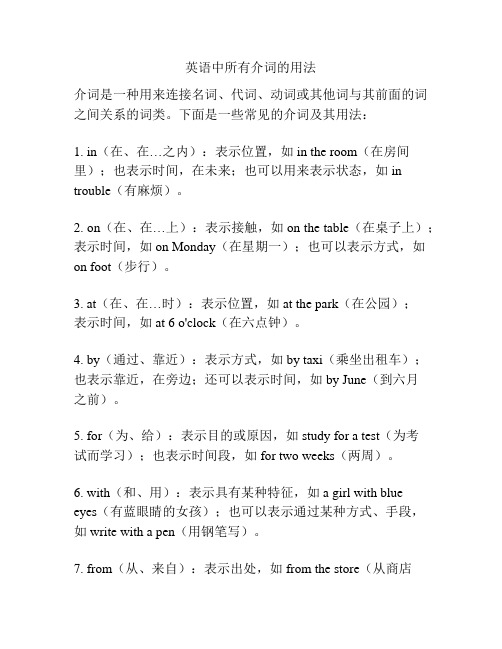
英语中所有介词的用法
介词是一种用来连接名词、代词、动词或其他词与其前面的词之间关系的词类。
下面是一些常见的介词及其用法:
1. in(在、在…之内):表示位置,如in the room(在房间里);也表示时间,在未来;也可以用来表示状态,如in trouble(有麻烦)。
2. on(在、在…上):表示接触,如on the table(在桌子上);表示时间,如on Monday(在星期一);也可以表示方式,如on foot(步行)。
3. at(在、在…时):表示位置,如at the park(在公园);
表示时间,如at 6 o'clock(在六点钟)。
4. by(通过、靠近):表示方式,如by taxi(乘坐出租车);也表示靠近,在旁边;还可以表示时间,如by June(到六月
之前)。
5. for(为、给):表示目的或原因,如study for a test(为考
试而学习);也表示时间段,如for two weeks(两周)。
6. with(和、用):表示具有某种特征,如a girl with blue
eyes(有蓝眼睛的女孩);也可以表示通过某种方式、手段,
如write with a pen(用钢笔写)。
7. from(从、来自):表示出处,如from the store(从商店
里);表示起点,如from London(从伦敦)。
8. to(到、向):表示目的地,如go to school(去学校);表示方向,如face to the north(面朝北方)。
这只是一部分介词的使用方法,介词的用法还有很多,需要根据具体语境来理解和运用。
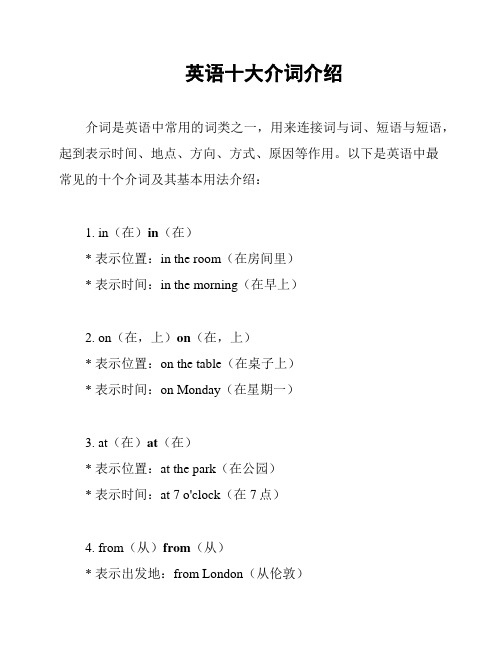
英语十大介词介绍介词是英语中常用的词类之一,用来连接词与词、短语与短语,起到表示时间、地点、方向、方式、原因等作用。
以下是英语中最常见的十个介词及其基本用法介绍:1. in(在)in(在)* 表示位置:in the room(在房间里)* 表示时间:in the morning(在早上)2. on(在,上)on(在,上)* 表示位置:on the table(在桌子上)* 表示时间:on Monday(在星期一)3. at(在)at(在)* 表示位置:at the park(在公园)* 表示时间:at 7 o'clock(在7点)4. from(从)from(从)* 表示出发地:from London(从伦敦)* 表示时间起点:from Monday to Friday(从星期一到星期五)5. to(到)to(到)* 表示目的地:go to school(去学校)* 表示时间终点:from Monday to Friday(从星期一到星期五)6. with(和)with(和)* 表示陪伴:go with friends(和朋友一起去)* 表示方式:write with a pen(用钢笔写)7. by(通过)by(通过)* 表示交通工具:travel by train(乘火车旅行)* 表示方式:send a letter by email(通过电子邮件发送信件)8. for(为了)for(为了)* 表示目的:buy a gift for mom(为妈妈买礼物)* 表示时间段:study for an hour(研究一个小时)9. about(关于)about(关于)* 表示主题:talk about the movie(谈论电影)* 表示内容:read a book about history(读一本关于历史的书)10. of(的,关于)of(的,关于)* 表示所属关系:a friend of mine(我的一个朋友)* 表示材料:a cup of tea(一杯茶)以上是十个常见的英语介词及其基本用法介绍。
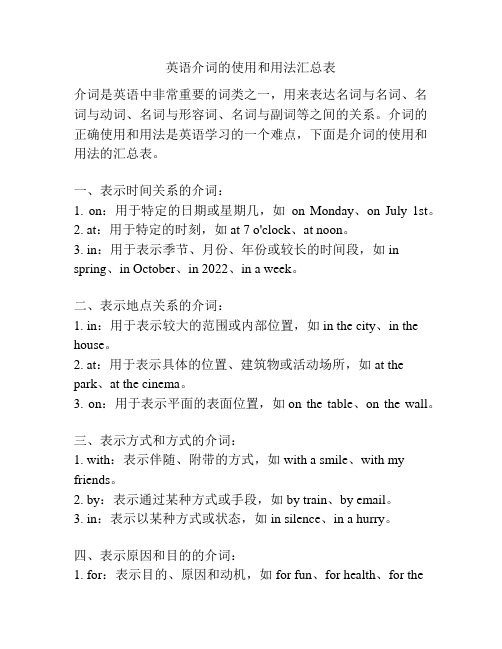
英语介词的使用和用法汇总表介词是英语中非常重要的词类之一,用来表达名词与名词、名词与动词、名词与形容词、名词与副词等之间的关系。
介词的正确使用和用法是英语学习的一个难点,下面是介词的使用和用法的汇总表。
一、表示时间关系的介词:1. on:用于特定的日期或星期几,如on Monday、on July 1st。
2. at:用于特定的时刻,如at 7 o'clock、at noon。
3. in:用于表示季节、月份、年份或较长的时间段,如in spring、in October、in 2022、in a week。
二、表示地点关系的介词:1. in:用于表示较大的范围或内部位置,如in the city、in the house。
2. at:用于表示具体的位置、建筑物或活动场所,如at the park、at the cinema。
3. on:用于表示平面的表面位置,如on the table、on the wall。
三、表示方式和方式的介词:1. with:表示伴随、附带的方式,如with a smile、with my friends。
2. by:表示通过某种方式或手段,如by train、by email。
3. in:表示以某种方式或状态,如in silence、in a hurry。
四、表示原因和目的的介词:1. for:表示目的、原因和动机,如for fun、for health、for thesake of。
2. because of:表示原因,如because of the rain、because of his mistake。
五、表示比较关系的介词:1. than:表示比较两个事物之间的差别,如taller than、more beautiful than。
2. as:表示与某事物相同或相似,如as tall as、as fast as。
六、表示紧接时间或顺序关系的介词:1. before:表示在某个时间或事件之前,如before class、before dinner。
常见介词及其用法。
答:一. 介词:介词是一种虚词,一般不重读,在句中不单独作任何句子成份,一般放在名词之前。
介词后面的名词或相当于名词的词语叫做介词宾语。
介词的英文缩写代表符号为:prep.
二.常见的介词有:
about、 after 、before、 among、 between、 beside、near、 by、next to、 in、out、 behind、 in front of、 up、 down、 on、 under、 with、 without、 at、 from、off、 to、 past、 like。
下面介绍一些常见介词的常见用法
1. About 大约,关于
Eg: He is about 7 years old. 他大约7岁了。
We usually talk about English. 我们经常谈论有关英语的话题。
2. After and before
这是一对反义词,表示时间上的"……之前"和"……之后"。
After 在…… 之前 before 在……之后
Eg: I have breakfast before school. 我上学前吃早饭。
I do my homework after school. 我放学后做作业。
3. Among and between
这是一对反义词,表示"在……当中"。
Among "在……中间",表示在三者或三者以上的中间;between "在……之间",表示在两者之间。
Eg: He is the tallest among the students. 在这群学生当中,他是最高的。
The apple is between two cups. 苹果在两个杯子之间。
4.Beside、 by、 near、 next to
这几个词都可以表示"在旁边,在附近,靠近"的意思。
区别在于:
by 和near表示"靠近,在……旁边"距离稍微远一些。
Eg: My house is by the river.我的家在河边。
I live near the park. 我住在公园附近。
Beside "在……的旁边,靠近",距离稍微近一些。
Eg: There is a book beside the pen. 钢笔附近有一本书。
Next to "与……相邻,紧挨着",距离更近。
Eg: The bedroom is next to the bathroom.卧室紧挨着浴室。
4. In and out
这是一对反义词, in "在……里面",out"在……外面"
Eg: There is a book in my bag. 在我的书包里有一本书。
Please look out of the window. 请看窗外。
5. Behind and in front of
这是一对反义词,behind"在……后面",in front of" 在……前面"
Eg: There is a boy behind the door.在门后面有一个男孩。
There is a tree in front of the house.在房子前面有一棵树。
6. On and under
这是一对反义词,On "在……上边",under"在……下边"。
Eg: The book is on the desk.书在桌子上。
The ball is under the chair.球在椅子下边。
7
. Up and down
这是一对反义词,up"向上", down"向下"。
Eg: Stand up, please.起立!
Sit down, please.请坐!
8. With and without
With "和……在一起"。
表示伴随。
Without "没有"
Eg: I often go shopping with my mother.我经常和妈妈一起去购物。
Fish can't live without water. 鱼离开水就不能活。
9. In、on、at
这三个词既可以表示地点,又可以表示时间。
1)表示地点
in 在……里面。
There is a book in my bag. 在我的书包里有一本书。
on在……上面。
The book is on the desk.书在桌子上。
at 在(指某一具体地点)。
My mother is at the bus stop. 我妈妈正在车站。
2)表示时间
in 表示笼统的时间。
Eg: I was born in January. 我出生在一月份。
On 表示具体的时间,在出现日期时使用。
Eg: I was born on June 5th. 我出生在六月五日。
At 表示时间的某一点。
Eg: I go to school at seven in the morning. 我早晨7点钟去上学。
10. Off 离开,脱离
Eg: The plane is taking off. 飞机正在起飞。
11. From 从…来
E.g: Where are you from? I'm from China.
你从哪里来?我来自中国。
12. To 到…
Eg: go to bed上床睡觉
Please come to my home tomorrow. 请明天来我家。
13. Past 过(时间表达词,一般在半个小时之内表示过了几分钟,这种表达法要先说分钟,后说小时,中间加介词past)。
Eg: I get up at ten past six. 我在六点十分起床
To 差(时间表达词,一般在半个小时以后表示还差几分钟就到下一个小时了。
这种表达法也是先说分钟,后说小时,中间加to. 但是所用的小时要用下一个小时
Eg: It is ten to one. 现在是12:50。
(差10分钟1点。
)
14. Like
这个词可以做动词,是"喜欢"的意思。
还可以做介词,是"象……一样"的意思。
Eg: You look like your mother. 你看上去很像你的妈妈。
(注:专业文档是经验性极强的领域,无法思考和涵盖全面,素材和资料部分来自网络,供参考。
可复制、编制,期待你的好评与关注)。